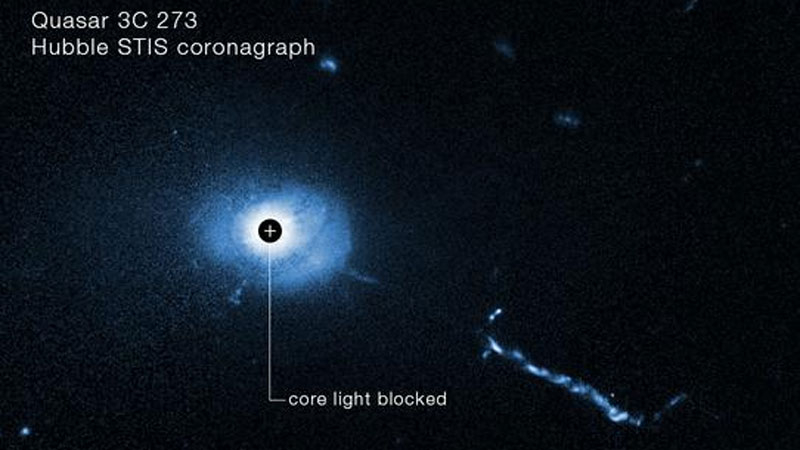Hubble for the first time saw the surroundings of a quasar and detected “drops” and a huge jet there


Quasi-stellar objects, or quasars, are active galactic nuclei, the light of which is thousands of times brighter than the light of all the stars of the host galaxy combined. It is extremely difficult to see anything close to a quasar. Meanwhile, the surroundings of quasars can tell a lot about their evolution and future. Hubble and a little trick made it possible to see the close environment of a quasar for the first time.


Image source: NASA
Astronomers have long learned to observe the Sun so that its brightness does not interfere with studying the atmosphere and corona. For this purpose, coronagraphs are used that cover the disk of the star. Hubble does not have such a device, but scientists used the STIS spectrograph installed on the telescope. The instrument’s sensor covered the central region of quasar 3C 273, which significantly reduced its brightness and made it possible to discern a number of interesting details.
Quasar 3C 273 was one of the first quasars discovered about 60 years ago and was the first officially confirmed object of its kind. It is located 2.5 billion light years from Earth. If the quasar were located just a few dozen light years away, it would shine in the sky like a second Sun.
Scientists compared the new image of the quasar 3C 273 with an archival image taken by Hubble 22 years ago. Thanks to the use of a kind of coronagraph, in the new image it was possible to discern previously inaccessible details – “drops” and a stream of gas 300 thousand light years long, which is three times the diameter of the disk of our galaxy, the Milky Way. The “drops” are likely dwarf galaxies attracted to the center of the quasar, a supermassive black hole. And the gas stream is a jet ejected by a black hole.
Objects near the quasar will sooner or later become “food” for the black hole, which will lead to new emissions of energy. Scientists are not yet entirely clear what exactly and in what sequence will be absorbed by the quasar. However, they intend to continue studying 3C 273 using the Webb telescope.
Recent Posts
A demo of Dispatch, a comedy game about a superhero agency from the former developers of Tales from the Borderlands and The Wolf Among Us, has been released on Steam
Developers from the American AdHoc Studio, founded by former Telltale Games, Ubisoft and Night School…
Digma DP-FHD800A LCD Full HD Projector Review: A Modern Approach
When you think about a home theater, you immediately imagine bulky projectors with a bunch…
Lian Li Introduces HydroShift II LCD-C Liquid Cooling System with 360mm Radiator and Three Configurations
Lian Li has introduced a series of maintenance-free liquid cooling systems HydroShift II LCD-C. It…
Apple: App Store App Developers to Earn $406 Billion in 2024
Amid mounting pressure from U.S. regulators, Apple has released the results of an independent study…
ASRock Admits Its Motherboards Break Ryzen 9000 Processors
Following a report from YouTube channel Tech Yes City that ASRock linked Ryzen 9000 processor…
Apple to Change OS Numbering: iOS 26 to Come This Year Instead of iOS 19
Apple is preparing a large-scale rebranding of its line of operating systems. This was reported…